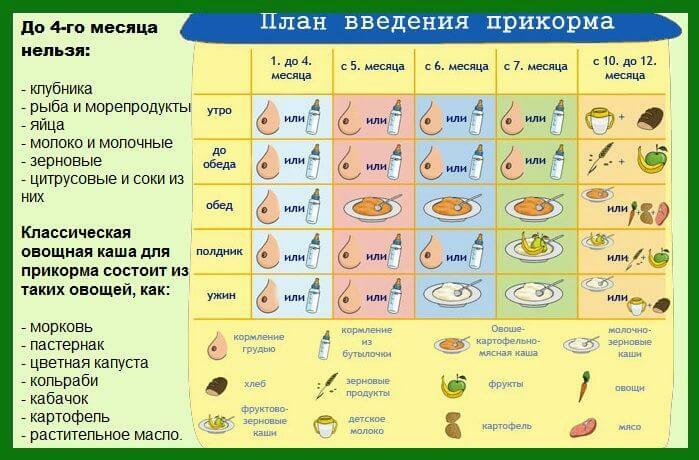Lure in 4 months: how to correctly spend, what products can be used

According to the norms of the World Health Organization, the first feeding of the newborn is given at the age of 6 months, if the infant is on artificial feeding, then it is allowed to shift the deadlines to 4, 5 - 5, 5 months .Many parents, after reading some questionable recommendations and having listened to grandmothers / girlfriends, begin to give food to the child at the age of four months.Indeed, many children respond adequately to such innovations, and their health does not suffer, but how justified are such actions from the point of view of medicine?
Contents: Physiology of a 4-month-old child Basic rules for introducing complementary foods in 4 months Products for first feeding in 4 monthsPhysiology of a 4-month-old child
To understand whether it is advisable to offer the first lure at 4 months, parents should understand, How the child is physiologically developed to this age. In general, at this age, the baby has cardinal changes in the digestive system:
- is actively producing hydrochloric acid, which is capable of activating enzymes that break down the food entering the stomach;
- intestinal walls thicken, large molecules can not penetrate through them;
- reflex ejection from the mouth of solid and / or thick food is lost;
- there are chewing movements.Judging by the listed processes, the child is quite ready to receive adult food, to the first lure already in 4 months. "
 "But the problem is that each child develops according to an individual schedule - someone has a readiness for supplementary feeding already in 4 months, and someone is not ready to switch to adult food by half a year.And if the parents did not evaluate the possibilities and abilities of the organism of their own baby, then after the introduction of complementary foods, intestinal colic, increased gas production, loose stools, insomnia and weight loss can be expected.
"But the problem is that each child develops according to an individual schedule - someone has a readiness for supplementary feeding already in 4 months, and someone is not ready to switch to adult food by half a year.And if the parents did not evaluate the possibilities and abilities of the organism of their own baby, then after the introduction of complementary foods, intestinal colic, increased gas production, loose stools, insomnia and weight loss can be expected.
To the above described troubles did not happen, you need to know the basic rules and features of introducing complementary foods to a four-month-old baby.
Basic rules for complementary feeding in 4 months

Sometimes the situation develops in such a way that the parents are forced to introduce the first complementary meal in 4 months - for example, it can happen on medical grounds: the baby was born prematurely, refuses milk or a mixture andLoses weight . Ignore such medical indications can not be, therefore it will be necessary to read and adhere to the recommendations of pediatricians:
-
 Start the first lure with vegetable puree, the main components of which are pumpkin, broccoli, zucchini, cauliflower and carrots.
Start the first lure with vegetable puree, the main components of which are pumpkin, broccoli, zucchini, cauliflower and carrots. - In 4 months the baby can be offered and porridge from rice, corn, buckwheat.These groats are hypoallergenic, but the child's organism can still react to them inadequately.
- If mashed potatoes or cereal are prepared according to clear recipes, then they should be marked "for baby food".
- Each new dish needs to be entered 1 time in 2 weeks - for 30 days the child will start using only two new products, but the body will be able to adapt to them, and in case of allergy symptoms, parents can quickly find out what it is.
- Even if the lure is started to give in 4 months, it is necessary to do it from a spoon - from a bottle the kid can drink only a mixture.Thus it will be possible to instill in the early age the basic swallowing reflex.
- For the first time, you can give your child only half a teaspoon of complementary foods, and then increase the dosage.The maximum daily intake of complementary foods in 4 months is 150 ml, and the approximate schedule for the introduction of new complementary foods may be as follows:
- 1 day - half a teaspoon;
- Day 2 - 1 teaspoon;
- Day 3 - 2 teaspoons;
- Day 4 - 5 teaspoons and so on, by 7 day the child should consume 150 ml of complementary foods.
- Any new product can cause an allergy in a baby, so parents should carefully monitor the baby's health.If after the use of a new product on his skin there are rashes, or there is a loose stool, then it is an occasion to immediately cancel the lure and consult with the pediatrician.
- You can not inject a baby to a baby who is sick or is preparing for vaccination.
Note: , before giving the first lure to a child at 4 months, you should consult a pediatrician who observes the baby from birth.
Food for the first complementary meal in 4 months
More recently, pediatricians recommended the first lure to give the baby fruit juices, but modern medicine insists that at 4 months of the first adult food should be vegetables or cereals.
Vegetable puree in early lure
At the age of 4 months, the child can be "introduced" only to certain vegetables - pumpkin, broccoli, zucchini, carrots and cauliflower.These vegetables in rare cases cause allergy, and in their composition contain just a huge amount of useful substances, vitamins and trace elements, necessary for the normal development of the child.Parents can buy ready-made vegetable purees - balanced, sterile and absolutely safe.But in addition to these positive qualities, such vegetable purees have a significant disadvantage - their cost is quite high. Young mothers can prepare vegetable purée for the first complementary meal in 4 months and independently:
-
 The selected vegetable is thoroughly washed and treated with boiling water, cleaned.
The selected vegetable is thoroughly washed and treated with boiling water, cleaned. - Then the vegetable should be poured with water and boil under a closed lid on medium heat for 10-15 minutes.
- The next step is shredding, which can be done with a fork or blender.
- If a child eats vegetable puree for a week and does not have any health problems, it will be possible to add 1-5 drops of vegetable oil to it.
Please note: is strictly not recommended to give a four-month-old baby a thick mashed potatoes, so it will need to be diluted with a decoction in which the vegetable was cooked.
Parents should know that the child is unlikely to show any particular enthusiasm for vegetable purée - he does not taste the taste, and after the mixture or breast milk he is still fresh.It is necessary to have patience and every time again and again to offer a new product to the baby - in a couple of weeks, he will appetite to absorb any vegetable purees.
Porridge in early lure
If parents start lureing at 4 months with cereals, then this "exercise" can be even more successful than when introducing vegetable puree.But here it is necessary to take into account that porridges have in their composition much less vitamins and trace elements in comparison with vegetable puree. Parents need to know something about porridges:
- For the first complementary meal in 4 months, you need to choose cereals without gluten - for example, corn, buckwheat and rice.Otherwise, the baby will be disturbed by intestinal colic, bloating.
- Specialists recommend purchasing single-component cereals in packages in dry form, which are sold in pharmacies or supermarkets.In principle, you can and prepare yourself a porridge for complementary foods in 4 months - you just need to grind the grits in a coffee grinder and boil in water.But the advantage of store packages is that in them the groats are further enriched with calcium and iron.
If the parents had to transfer the child to adult food from the age of four months, then by the age of 5 months he must switch to a new food instead of two feeds with a mixture.For example, in the morning he can eat 150 grams of porridge, and at lunchtime the same amount of vegetable puree, but the rest of the time the baby should be fed either breast milk or an adapted mixture for artificial feeding.
Tsygankova Yana Aleksandrovna, medical reviewer, therapist of the highest qualification category



